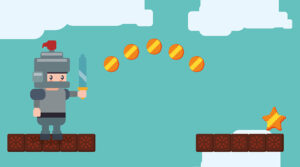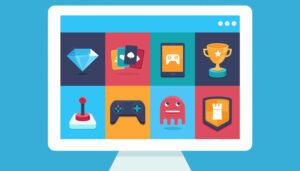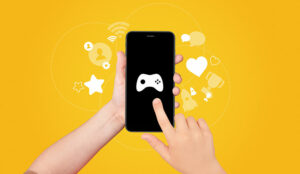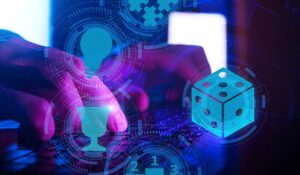Adam Aftergut is a product marketing manager for NICE Performance Management. He specialises in software used by contact centres to improve customer satisfaction scores (CSATs) while reducing contact center operational costs, In this guest blog he talks about driving employee engagement by applying game mechanics in the workplace, otherwise know as Gamification.
Google gamification, and you’ll unearth theoretical treatises and complicated case studies in abundance. But gamification doesn’t have to be a challenge – in fact, it can be broken down into 10 basic principles, or game mechanics1. The right combination of these mechanics can push service and sales organisations to new heights.
Keep reading for examples of gamification in real-world settings and virtual environments that can be easily adapted to your business.
Game Mechanic #1: Badges & Recognition
Humans generally crave outward recognition, and gamification can create a digital system for acknowledging successes. Employees who have completed a challenge are rewarded with a symbol of their achievements, like a badge. Those badges allow them to review their accomplishments, set goals for specific levels and support each other in their work.
Example: Home Depot is known for its informed and helpful service, and part of that service is driven by a recognition system. Employees display their expertise on their iconic orange aprons, with badges that indicate their credentials in a specific department or skill. Co-workers and customers can see who has a specific certification and reach out for help or advice accordingly. Employees have a visible record of the trainings they’ve completed and skills they’ve added, which can help accelerate careers and growth within the company.
Game Mechanic #2: Friendly Competition
A healthy dose of competition can provide a big push. When a colleague earns a distinction or moves up the leaderboard, others want to prove their mettle. Competition, however, needs to be handled with care. Pairing team and individual competitions that are woven into day-to-day work helps create a positive atmosphere. Highly interactive gamified competition, in which users have real-time access to current scores and standings, pushes workers to excel.
Example: The Nike+ app has received numerous accolades for its use of social media in gamification. Users can share their running stats online to earn bragging rights and challenge their friends. This competition drives users to push themselves ever farther – while sharing Nike’s name in the process.
Game Mechanic #3: Fast Feedback
At its core, fast feedback connects behaviour to results, quickly. Is an employee performing better today than yesterday? How does she compare to co-workers? What did the last five customers say about her interactions today – not last week? When employees receive fast feedback, accountability replaces guesswork. Frequent updates increase engagement and allow participants to track their progress in small bites and self-correct as needed.
Example: Arbonne, a Swiss personal care and wellness products company, optimises performance in its call centers through a system of ongoing feedback. Agents and their managers can immediately see their post-call quality evaluations. By displaying this data, the system enables self-management and proactive performance monitoring.
Game Mechanic #4: Leaderboards & Transparency
Many companies benefit from a gamified twist on the old-fashioned leaderboard. The system is transparent, and each employee knows exactly where he stands relative to goals and to teammates. This digitised version is flexible, constantly updating and complete. With a digital leaderboard, even an agent who ranks near the middle or the bottom on a KPI has total visibility into his or her relative performance.
Example: The American Airlines and US Airways merger, which brought significant changes to the contact center organisations of both legacy carriers, offers a glimpse into transparency in action. A new performance management solution simplified the process by increasing users’ access to data3. Agents can now see where they rank numerically among teams and other peer groups. In addition to earning company-wide bragging rights, tighter connections between the performance management system and revenue incentives help agents ensure that their targets and goals are being tracked correctly.
Game Mechanic #5: Storytelling & Engagement
Storytelling can create new insights that break down the traditional rigidity of business. Powerful stories entertain and engage while informing and can incentivise action and align employees around organisational priorities and goals.
Example: Like most businesses, Allstate Insurance Company strives to maintain internal and legal standards.
However, rather than using tiring seminars or booklets, Allstate’s staff learns about compliance through a game with superheroes, villains and videos. It teaches them everything they need to know about corporate expectations and standards and then quizzes them to measure comprehension and “level up.”
Game Mechanic #6: Going for Goals
Goal-setting is one of the most effective ways to drive improvement and progress5. It clarifies expectations, drives engagement and increases confidence, offering benefits for individuals and groups alike. Using a data-driven approach in the workplace can challenge employees to work towards incredibly specific key performance indicators.
Example: Fitness trackers like Fitbit allow users to follow progress and set regular goals for activity. The devices drive accountability, empower users with knowledge and incorporate social elements. At the end of a workout (or a day or week), users can see how their progress stacks up against their fitness goals.
Game Mechanic #7: “Level Up” for Achievement
Levels can be used to encourage exploration in new areas and reward employees for expanding or refining skills and/or adding to their knowledge. Some companies are even tying gamification levels to career paths. They define the specific levels that must be achieved to indicate readiness to advance to a new role or department. Employees can then seek out and complete those levels to demonstrate their interest and aptitude.
Example: Google’s Local Guides resource uses this game mechanic as an incentive for users to provide details on everything from the availability of parking at the grocery store to the atmosphere of a restaurant. Collecting that data has been crowdsourced through gamification: Android and Google+ users level up as they earn points for submitting photos and answering questions about a location. With each new level comes new options, resources and rewards.
Game Mechanic #8: Collaboration
Games aren’t only about competition. They can also be used to inspire collaboration. Gamification in the workplace creates opportunities for co-workers to help one another succeed—when collaboration is a central tenet of a gamification program, employees can more easily find the insight or answers they seek.
Example: T-Mobile incorporates gamification to encourage employees to participate in a knowledgebase. Users earn points for using the system correctly and awards for contributing their own knowledge. The interactive platform drives both competition and collaboration between team members.
Game Mechanic #9: Community
Creating a community component of gamification can increase engagement as people drive, reinforce and challenge one another. If one user shares his experience with new challenge, suddenly a handful of people explain how they handled the situation. Employees are more committed and engaged when they feel like they’re all in it together.
Example: SAP has invigorated thousands of experts through gamification. The company has more than 100,000 expert users registered for its online community, where customers search for information and ask questions. The more answers and ideas an expert contributes, the more points he or she accumulates. Those points translate into tiers – silver, gold, platinum, etc. That’s currency these experts can use; it’s prestigious and marketable to be a platinum community member.
Game Mechanic #10: Pointsification
Almost every game has some type of point system, and it is human nature to want to grow the balance. Unlike old-fashioned systems though, gamified points are digital and lasting. A quick tally can help employees and managers identify consistent performance, evaluate their standing at any given moment and recognise what’s needed to earn more points. Rewarding positive behavior with points – which can be redeemed for prizes or privileges – is the oldest tactic in the book, and gamification makes it even more powerful.
Example: The Starbucks Gold Card is a renowned status marker amongst the caffeine junkies of the world. Starbucks gamified rewards years ago by creating a social hierarchy based on levels of spending. Members earn “Stars” with every dollar they spend and can eventually achieve Gold status. Those customers receive a Starbucks Gold Card with their name on it and get access to exclusive perks like free drinks.
Organisations that borrow from these 10 core game mechanics can engage employees and improve performance — up to a 25-percent increase in productivity, a 90-percent reduction in training time and a 70-percent reduction in the cost to onboard a new hire. When tied to relevant KPIs and employee goals, gamification helps companies incent the behaviours that drive powerful improvements, all while making work increasingly fun.
Author: Rachael Trickey
Published On: 2nd Dec 2016 - Last modified: 14th Feb 2025
Read more about - Guest Blogs, NICE


















